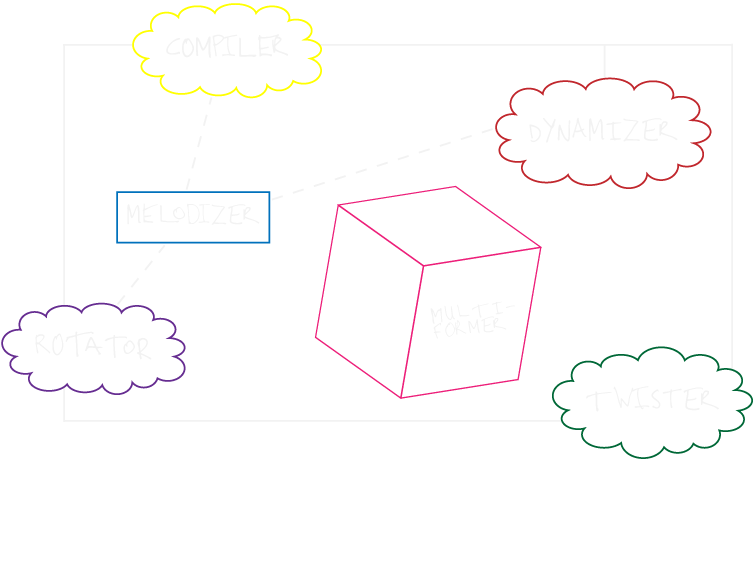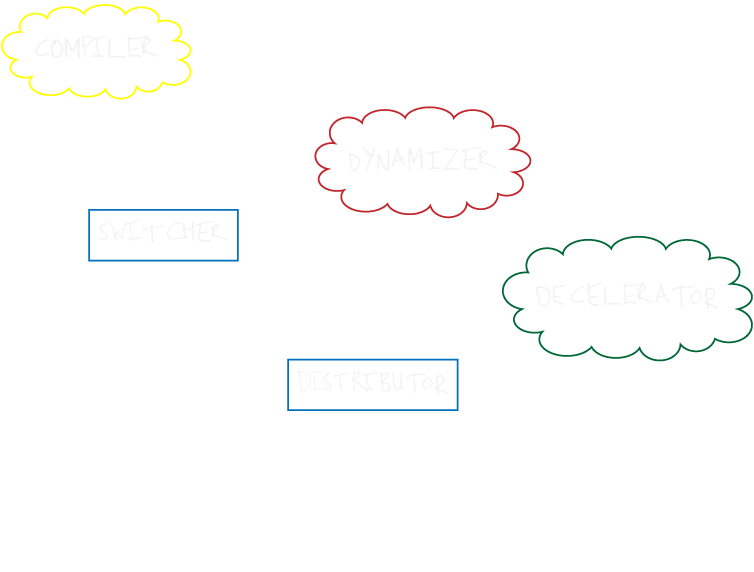Reflections while listening
Anna:
ett underjordiskt knarr, en välvande underground
blir sökande punkters svävande
påståenden.
frågor?
cembalon smakar barock vagga, vagga flageoletten, stannar i grus
vad slår mot strängen, mot träet?
pauserna krymper
vagga snabbare!
ljust och grumligt
(välvande underground pockar igen) fåglarnas blockflöjter plockar och glider
mot rytmer
glasharmonikan dras av en knarrande vagn - kugghjul
korta virvlar – ut vänster
(Alla fördjupade i sitt eget gemensamma samtal)
Katt:
Opens with a murk of tick and growl in the synth, smearing into an abrasive of over pressured bowing in the strings. The effect is a dark, sullen texture. It transforms into pointalistic, slow-moving counterpoint, the undertow evaporating into a delicate music-box, event for event, the low synths transforming into austere gestures. Non-patterns join in see-saws and fragments, then disintegrate, as the music thins out more and more. Delicate, tiny artifacts spindle over the dark growl of the synth and bass. These are two entirely different groups of form, moving slowly against one another in miniature tectonic counter-play. At the halfway point the group unifies into a mixture of both materials, then the form returns to the original low-sounding murk, disintegrating once again into single-point collective non-phrasing. A third of the way through, a focus forms about the percussion, imbibing and returning materials from the others in short, articulated events. They are events and not phrases- materials interlock as phrases only collectively until a violin enters overhead with a harmonic melody. Slowly the materials form a clockwork around it, departing to leave only the bass tying all together in a single, multi-idea containing tremolo.
This improvisation sets its originating modulators – the attractor Twister and the connector Multiformer – in careful balance against one another. It illustrates how the modulators both limit and, through those limits, free both languages of playing and practices of spontaneous form. Multiformer has the following instructions: “create a collectively (quasi-)synchronized pattern of recurrent and conjoined territories; a multiplicity of “affective spaces” or “plateaus” that create a sense of continuum.” [from the Modulators document draft]. Here the territories are stark, and need not be more than few- there is the ticking, ___ing synth and bass in the beginning, and the delicate, gestural territories of the other strings and percussion that follow. The ensemble rearranges itself into synchronous sub-groups throughout the improvisation drawing on the continuum of the originally stated materials in an austerely focused way. Twister, the other modulator in use, instructs “Use primarily sustained sounds in “convoluted” or “confused” spectromorphological entwining, as in “coiling”, “twisting”, etc. Use slow, gradual changes of timbre.” [from the Modulators document draft]. This improvisation features one of the primordial affects of spectromorphology: the shift from rhythm to pitch found at the lowest end of the audible spectrum, originally explored by Stockhausen in the 1950s and 60s. Described in his work Kontakte, it is described: “A pulse-based noise tone wavers and falls. At the same time its frequency-filtered bright tone layer (“pitch”, essentially) becomes darker and then brighter again. Then the pitch gradually zigzags down, slows down, plays a 7-note “melody”, finally becomes individual pulses, gradually lengthening” [from http://stockhausenspace.blogspot.com/2015/08/stockhausen-on-electronic-music-wdr.html, referencing http://www.karlheinzstockhausen.org]. The “coiling” motions are sometimes construed literally, with the coiling of bow-hairs pulled sideways against the string or percussion sticks “coiling” against surfaces, and sometimes motificly, with the zig-zag, growling and softly hocketing figures appearing throughout the improvisation.
This improvisation illustrates how the combination of two modulators creates focus by introducing uncertainty. Where it would be rare for an entirely spontaneous improvisation to feature such a highly developed principle of self-organization (although it does happen occasionally and unpredictably in improvised music’s most miraculous moments), the use of these conceptual tools allows the group to move directly into the sophisticated manipulation of form and materials, using a very sparse set of ideas, to spin out complexity.
Vilhelm:
Lågt synt- och stråkmuller och enstaka attacker i trummor bildar känslan av en transparent miljö
eller landskap. Ett kollektivt åskmoln med konturer och rörelse inom sig där olika hastigheter och
tonhöjder bitvis träder fram i ljuset. Smygande kommer toner fram ur texturen och en cembalo
och fiol hörs, i en glänt i ett eko av kammarmusik. Åskan finns kvar bakom kullarna. Hotar.
Fiolostinato i en återkommande sekund.
Paus
Linjer
Paus.
Ljusstrimma och åska i en annalkande storm? Metall. Syntglissando som etableras i ensemblen,
material återkommer format av det som tidigare hänt. Åskan glider, glissandona åskar.
Intensiteter byggs upp – bryts - startar - förtunnas - förtätas – skapar sina egna linjer och
tyngdpunkter.
Små regndroppar sprids ur synten och trummorna borrar i starka inpass. Svaga studsande stråkar,
ett eko från synten, blandas med brutalare borrande glesa insatser från resten av ensemblen.
Genomsläpplighet och disponerad dynamik över ensemblen i olika skikt. Material återkommer;
Åskan hotar återigen men på annat sätt, nu på andra sidan sjön medan djurlivet återigen
kommunicera med varandra på denna sida sjön. Ljusa läten – is? insekter? Så plötsligt blir det
tyst, där en får känslan att miljön fortsätter och att det är bara inspelningen som stängts av.





